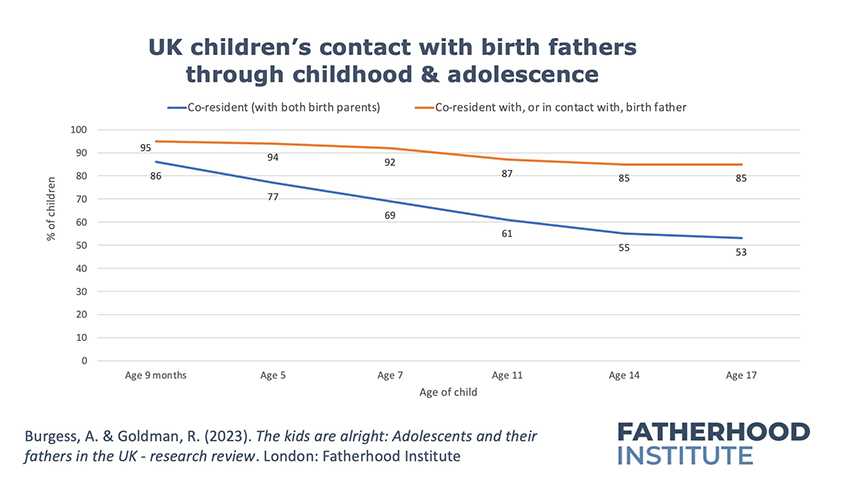 A father holding hands with his two children
A father holding hands with his two childrenDads feature in the lives of the vast majority of children. In Millennium Cohort Study (MCS) data (see chart below), 85 per cent of 17-year-olds lived with or were in contact with their birth father, even though around half were by then not living with both birth parents at the same address.
All these fathers are important, but much data about them remains overlooked in secondary analyses of the UK’s large-scale quantitative longitudinal studies.

Dad-shaped holes and why we should fill them
Let’s first look at the ‘dad shaped holes’ in secondary analyses focused on childhood and parenting, which we set out in our recent Nuffield Foundation-funded review of ‘father-data’.
Sometimes, data about fathers and mothers is analysed together as ‘parental’ data, without disaggregating parent gender or relationship-to-child. Other times, researchers use the terms ‘parents’ and ‘parenting’ but analyse or report data about mothers only, masking the omission of father-data. Other times they assume father ‘absence’ when parents do not live together, and assess the impact of ‘family structure’ without taking into account the time fathers who ‘live elsewhere’ (often called ‘non-resident’, but we refer to them as ‘Own Household Fathers’) spend with their children, and the quality of that relationship.
These are weak approaches to understanding children and their outcomes. Fathers and mothers, including Own Household Fathers, have distinctive independent effects on their children. For example in MCS data, father-child closeness has a greater impact than mother-child closeness on adolescent risk behaviours. Even when researchers are specifically interested in mothers, father-data is vital. If analyses do not control for fathers’ involvement and characteristics, apparent ‘mother effects’ may represent the impact of both parents and their co-parenting.
A wealth of father-data
We reviewed the ‘fathers-of-adolescents’ data collected in the MCS, the Avon Longitudinal Study of Parents and Children (ALSPAC), the first Growing Up in Scotland birth cohort study (GUS), the first and second LongitudinalSurvey of Young People in England studies (Next Steps and Our Future) and Understanding Society. We then compared the father-variables collected to those used in published analyses in the Fatherhood Institute’s systematically-compiled, comprehensive Research Library (available for external use).
While the number of secondary analyses of the dad-data has increased substantially in recent decades, we still found much that has been collected but rarely used in published secondary analysis.
New opportunities
Least used, for both co-resident and Own Household Fathers, are variables about the extent of father and child co-residence, types of father engagement, father involvement in their children’s education, father responsibility, and co-parenting. Recently added to the UK Data Archive are symmetrical data from fathers and adolescents on father-child relationships, and from fathers and mothers on co-parenting (GUS ages 12 and 14); child-completed diary data on time with fathers (MCS age 14); the frequency of older adolescents’ in-person and ‘virtual’ interactions with own-household fathers (MCS age 17); and father parenting style, and relationships between children/youth and their birth and ‘step’ fathers (recent waves of Understanding Society). It is an excellent time to make use of such wonderful and under-used data, with the children in the MCS and GUS now young adults.
Data about contemporary fathers to look out for in the near-future include that currently being collected in the Early Life Cohort feasibility study (babies) and the Five to Twelve and Growing Up in the 2020s cohort studies (primary-and-secondary-school-children); and enhancements to Understanding Society.
And let’s not forget the older father-data collected in long-running child-cohort studies such as the 1970 British Cohort Study and ALSPAC. These give the opportunity to study long-term impacts of fathers and fathering, including intergenerational effects on grandchildren.
Fatherhood Institute resources for secondary analysts
Factors in the under-use of this father-data may include sample sizes and data quality, and the data only recently becoming available for analysis. However, there may also be a lack of researcher knowledge of the variables collected (see a similar conclusion here in relation to under-use of Understanding Society child-development-variables).
Our recent publication, The kids are alright: adolescents and their fathers in the UK - a review of data in six longitudinal studies, along with our reviews of antenatal and postnatal father-data (also funded by the Nuffield Foundation), are resources for analysts in the fields of child development, adolescent and youth studies, family studies, education, public health, bio-social research, and social mobility/economic studies. For The kids are alright, we created a conceptual father-factor framework categorising variables collected about father involvement, father-child relationships, parenting style, co-parenting and other aspects of fathering.
In conclusion, we encourage researchers to incorporate rich data about fathers already collected in the UK's internationally-renowned quantitative longitudinal studies to update our evidence base about fathers' and mothers’ impacts on children. The Fatherhood Institute is available for advice and discussion.

